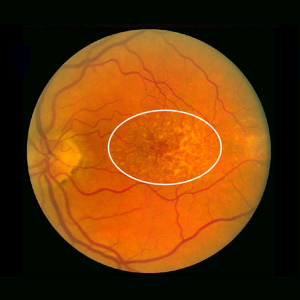Vision Loss and V1
87
Learning Objectives
Be able to describe the cause of macular degeneration.
Know what the two main types of age-related macular degeneration are.
Age-related macular degeneration (AMD), the leading cause of worldwide blindness in the elderly, is a bilateral ocular condition that affects the central area of the retina known as the macula. The macula accounts for almost 10% of the entire visual field. Thus, lesions developing in this region can have a major impact on visual function.
The two main types of age-related macular degeneration are dry and wet. Age-related macular degeneration is generally thought to progress along a continuum from dry AMD to wet AMD. Dry AMD is progressive, with gradual loss of visual function that may span over many years. The typical clinical sign of dry AMD is the pigment disruption and drusen (small yellowish deposits in Fig.9.3.1) in the retina. Approximately 10-15% of all AMD patients will eventually develop the wet form. Wet AMD implies that fluid, exudates, and/or blood are present in the extracellular space between the neural retina and the RPE (i.e. the subretinal space) and/or, as in the case of RPE detachments, between the RPE and Bruch’s membrane (i.e. the sub-RPE space). Wet AMD can advance to severe central vision loss.

Webvision: The Organization of the Retina and Visual System, Age-related macular degeneration (AMD)
Authored by: Gregory S. Hageman, Karen Gaehrs, Lincoln V. Johnson and Don Anderson
URL:https://webvision.med.utah.edu/book/part-xii-cell-biology-of-retinal-degenerations/age-related-macular-degeneration-amd/
License: CC BY-NC

